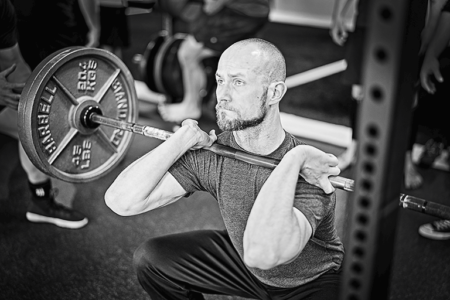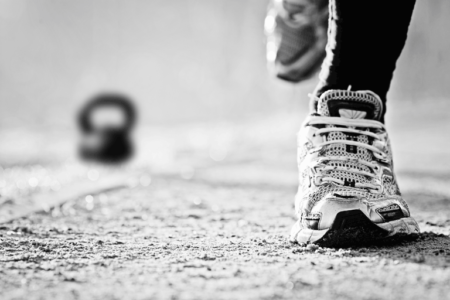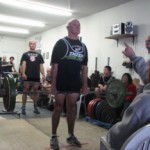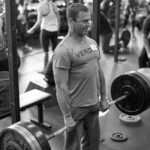With August upon us, members of the StrongFirst community from the New York City area and elsewhere have already begun their preparations for the 2018 New York City Marathon.
Wait a minute. That can’t be right!
Marathon training inevitably cannibalizes muscle and leads to a loss of strength. I’m not entirely sure, but I think it has something to do with the disappearance of honeybees too. You’d have to be some type of masochist to engage in such behavior!
Well, for the last three years, I’ve been that type of masochist.
My First Marathon
In 2015, I ran my first marathon ever (see addendum for how I got this brilliant idea in the first place). For 16-weeks, I followed a typical running-focused preparation program. No kettlebells. No calisthenics. No strength work. Not even an online strength forum! Unsurprisingly, as the miles increased, my bodyweight and strength decreased. I’m not sure how many honeybees disappeared as a result. In spite of my somewhat depleted state, I still managed a subjectively respectable 3h:10m time at a pace of 7:17, on race day.
But perhaps worse than the weight loss; than the strength loss; than the vanishing honeybees, were the pains that struck almost immediately following the race. Have you ever had to walk down a flight of stairs backwards? Well, I can give you 26.2 reasons why you might have to. My ego wasn’t spared either. For a day or two, I was still able to convince myself that my running had looked like the opening scene of ‘Chariots Of Fire.’ Unfortunately, a bubble-bursting company called MarathonFoto emailed images of me running through city streets, sadly looking more ‘Quest For Fire’ than ‘Chariots of Fire.’ So there I was: a limping Paleolithic Man, weak, dejected, and approaching seventeen weeks of strength withdrawal.
Enter (Barbell) BDSM
Signing on to the StrongFirst website shortly thereafter, my eyes were immediately drawn to the NYC SFL Certification, just a few days away. No physical pain, weakness, or battered ego could keep me from seizing this special training opportunity.
So less than one week after that torturous race, I entered the world of BDSM—Bench, Deadlift, Squat and Military Press. What’d you think it meant?
I spent the following weekend learning these four lifts, their preparatory drills, accessory movements, and variations in great detail. Under Dr. Hartle’s constant reminder that the goal wasn’t to “make powerlifters,” he explained each technique, its application, and its programming. He also explained the methods to combine barbell training with other athletic pursuits as well as ‘real life.’ Performed correctly, each of the lifts was essentially a full body exercise. Running is also a full body exercise. I couldn’t wait to apply the knowledge.
 Though I had run for four months during my marathon training, running did not pay the bills. The weight and strength losses had hindered my job performance. I would never let that happen again. Through the SFL Certification, I was reminded of the importance of being “StrongFirst,” not just through affiliation but in practice. My base in strength training had undoubtedly contributed to my prior successes professionally and in running. To negate or ignore that aspect of training was a mistake I would not repeat.
Though I had run for four months during my marathon training, running did not pay the bills. The weight and strength losses had hindered my job performance. I would never let that happen again. Through the SFL Certification, I was reminded of the importance of being “StrongFirst,” not just through affiliation but in practice. My base in strength training had undoubtedly contributed to my prior successes professionally and in running. To negate or ignore that aspect of training was a mistake I would not repeat.
Keeping the StrongFirst influence intact for the 2016 NYC Marathon, I added strength training to running. But I quickly realized that the combination of volume, intensity and overall stress was nearing a breaking point. Fully aware of what was happening, I made the fortunate mistake of misreading the instructions of the SFL Manual as well as Pavel and Dan John’s ‘Easy Strength,’ and began to couple the ‘Even Easier Strength’ 40-Day Program with my marathon training. The results were outstanding. Saying that I didn’t lose weight would be a lie. Running over seventy miles a week makes that pretty hard to avoid. But the neurological effect of training with the Even Easier Strength protocol was instrumental in maintaining my strength, preserving some muscle mass and speeding my recovery.
So in November 2016, I finished my second Marathon in 3:01:35, at a pace of 6:56. Not only did I experience minimal pain after the race, I felt no weakness and recovered well. Walking downstairs correctly wasn’t a problem. Though MarathonFoto still mocked me with their images, they may have looked a little better than those of the year before, and I definitely felt a whole lot better. Completing the Marathon on Sunday, I was back under the bar by Wednesday. After all, there was now a new challenge…only ninety-five seconds had just separated me from a sub-3 hour marathon.
Run. Run Stronger. Run Stronger and Smarter.
In 2015, I ran. In 2016, I ran stronger. In 2017, by applying the lessons learned through experience and StrongFirst principles, I would run stronger and smarter.
 Maintaining strength had been critical to my previous performance and relatively easy recovery, not just after the race but throughout the preparation. I knew it was a must so I kept barbell training and added my kettlebell instructor re-certification training for good measure. When I felt my running volume was affecting recovery, I took a week off (from strength training), then re-applied a modified version of Pavel and Dan John’s 40-Day Program. I allowed myself to play with set and rep ranges so I could vary the intensity and, more importantly, have fun with the training. Plus, I was a little less strict with the frequency, being sure to distinguish recovery from laziness
Maintaining strength had been critical to my previous performance and relatively easy recovery, not just after the race but throughout the preparation. I knew it was a must so I kept barbell training and added my kettlebell instructor re-certification training for good measure. When I felt my running volume was affecting recovery, I took a week off (from strength training), then re-applied a modified version of Pavel and Dan John’s 40-Day Program. I allowed myself to play with set and rep ranges so I could vary the intensity and, more importantly, have fun with the training. Plus, I was a little less strict with the frequency, being sure to distinguish recovery from laziness
In addition, rather then stopping my strength training one month out, as in the year before, I continued strength training until one week before the marathon. On that day, I pulled around 2-1/2 times my bodyweight for an easy double. A week later, I finished the marathon in 2:57, at a 6:48 pace. Those MarathonFoto images arrived a few days later, containing something unseen in previous years. A smile.
Extract from my Training Journal from October 2017
Part of my last “block” of strength training program (actually Pavel and Dan John’s program), which coincided with my ‘tapering’ for the Marathon on 11/5/2017. Only the “work sets” are listed.
10/21 – Run 15.95 miles / 2h00m / 7:31 pace
10/22 – Run 8.16 miles / 1h00m / 7:21 pace + DL 2×5, MP 2×5, BB Curl 2×5, 1H KB Swings 2×25, HLR 2×9
10/23 – Run 8.19 miles / 1h00m / 7:20 pace + DL 2×5, MP 2×5, BB Curl 2×5, 1H KB Swing 2×15, HLR 2×6
10/24 – Run 8.53 miles / 1h00m / 7:08 pace (Intervals) + DL 2×5, MP 2×5, BB Curl 2×5, 1H KB Swing 2×17, HLR 2×6
10/25 – Run 6.10 miles / 0h45m / 7:23 pace + DL 6×1, MP 6×1, BB Curl 6×1, 1H KB Swing 2×15, HLR 2×7
10/26 – Run 8.35 miles / 1h00m / 7:11 pace (Tempo) + DL 1×10, MP 1×10, BB Curl 1×10, 1H KB Swing 1×10, HLR 2×5 (tonic session to recover from the previous ‘heavy’ singles)
10/27 – Run 6.12 miles / 0h45m / 7:21 pace + DL 5×2, MP 5×2, BB Curl 5×2, 1H KB Swing 21×2, HLR 2×6
10/28 – Run 8.14 miles / 1h00m / 7:22 pace (LSD)
10/29 – DL 5/3/2, MP 5/3/2, BB Curl 5/3/2, 1H KB Swing 2×25, HLR 2×7
Learning from Experience, My Own and Others’
So, what have I learned?
Ultimately, I have learned the importance of “StrongFirst.” As indicated by Professor Leonid Mateev, “Strength is the foundation for developing the rest of physical qualities.” Each of the achievements mentioned is based upon being strong first. From training to trainer at the Academy. From kettlebell instructor to runner. From Barbell Certification to a sub-three marathon finisher (all at over forty years old).
The StrongFirst community has provided the opportunity, the instruction, and the inspiration behind these achievements. Hopefully, this article, as well as the community, may help others towards their own goals.
Having recently re-certified for my SFL, I’ve already taken the first step towards my next goal, whatever that may be.
Addendum: A Girevik’s Return to Running
In 2013, returning to the Training Academy as an instructor, running became a part of my regular duties. Not having run since the mid-nineties, as a candidate in that same academy, I questioned how hard could it possibly be—after all, I was now a certified kettlebell instructor.
Well, it turns out pretty hard. Particularly when kettlebell ballistics and grinds were your primary preparation. Sure, I added a few weeks of ‘jogging’ before starting my new assignment. But you can’t call what I did ‘running.’ No ‘WTH Effect’ could prepare me for my first ‘run’ in seventeen years.
What’s worse is that my new coworkers lulled me into my first-day run with lies: how short it would be (“junk miles”) and how slow it would be (“easy pace”). So I confidently strode out on what ultimately came to a little over five miles, at around an 8:00-minute mile pace. Finishing well behind my ‘team’. My ego was destroyed.
“Gasping for air with my tongue hanging out” as the most experienced runner of our group later described it, I asked, “what do I do?!?” He suggested the obvious: to run. But waving the load with a variety of distances at different speeds.
After three months of training, I would finish the Staten Island Half Marathon in 1h:40m at a pace of 7:40, only partially erasing the humiliation of that first-day run. But I was pretty content. I could still practice my kettlebell ballistics and grinds and, when required, run at a subjectively respectable pace—never far enough to be mistaken for a runner though. Or so I thought.
For two years, another part of my job description had been to help coworkers with their own NYC Marathon experience. Working behind the scenes at the 2013 and 2014 events had sparked my curiosity on how the other half (those running the race) lived. In 2015, I would begin my own Marathon experience, becoming one of them… only stronger!





I really enjoyed this article, Brian. Thanks for taking the time to share your story.
I too have gotten into marathon running in the last 18 months. Combining strength training with the longer cardio sessions is something I am still experimenting with.
If you have time, could you please answer the following questions?
1. Can you elaborate on the nasal breathing protocol you followed? I am just starting out with Brian Mackenzie’s nasal breathing…
2. What led you to choose those particular exercises for the “40-Day Workout” strength program you followed?
Mr. McManus:
Glad you enjoyed the article. Hope you can derive some information to assist with your own training pursuits.
Reflecting on the article, and my own training, I’ve discovered (or finally admitted) that my protocols are utterly unoriginal. My strength and endurance programs come from a variety of sources. If there is any originality, it is only in their combination.
With regard to breathing, the technique was derived from John Doulliard’s ‘Body, Mind, and Sport.’ In the text, he refers to it as the Darth Vader breath. Further investigation has led me to discover what is called Ujjayi within Yoga circles. Regardless, that is the breathing technique I employ while running. Fortunately, kettlebell ballistics practice familiarized me (and everyone around me) with hearing my own breathing.
As for the cadence of the breath, I think it was derived from Danny Dreyer’s ‘Chi Running.’ Simply put, the exhalation is one step longer than the inhalation. At slower paces, the inhalation may be four steps long with an exhalation lasting five steps. At speed, if I’m able to maintain nasal breathing, a two step inhale and three step exhale is most common.
It should be noted that though the pace and breathing changes, the cadence does not. 180 steps per minute is the typical cadence with a change in stride length affecting the pace. I have used a metronome for this type of training and find it very useful.
Equally useful or maybe more was the 40 Day Program, from Pavel and Dan John’s ‘Easy Strength.’ The program has been reintroduced, revised, and reissued by Dan John on the internet, but its basic structure remains intact.
The core of the program consists of five movements: a large posterior chain movement (deadlift, in case you were curious), an upper body push, an upper body pull, a simple full-body explosive move (KB swings or snatches), and an anterior chain move (an abdominal exercise). There are some variations that prescribe a push, a pull, a hinge, a squat, and a carry, but you get the general idea.
In my own application, I used the former example, always using a squat movement in the warmup. The movement chosen would often balance the posterior chain movement. For example, if I was doing a conventional deadlift, the warmup would include a front squat.
With balance in mind, the upper body press would influence my explosive movement. In short, I would always want to put weight overhead. Bench presses were paired with KB snatches, and military presses with KB swings. The pull was paired with the abdominal exercises in that, with deadlifts always present, I wanted to hang from a bar. So, if I did pull-ups, I used the ab wheel. If i did curls (running in a singlet, sun out guns out!), I would do hanging leg raises. Over time experience and effects would dictate which combinations worked best.
Hope this answered your questions, keep me posted upon what works best for you.
Thank you very much for the thorough response, Brian. You have provided some valuable motivation/inspiration and given me much to work with.
Great article and excellent time.
I think you point out a very important aspect: being stronger will help a runner to maintain a good posture. A better posture means less risk of injury, but also running economy, therefore performance.
Mr. Lopez:
Thank you for adding the postural aspect, I agree wholeheartedly.
In both running and strength pursuits, I encounter innumerable individuals who are unable to do this or that because it hurts or that they are no longer able.
Had they stressed technique, practicing rather than performing, to their training, I believe that they’d still be able to engage in whatever activities they wished.
As indicated in the article and reinforced by Mr. Brett Jones, “Strength is the master quality.” I would add that skill in its application will ensure its quantity.
Strength is the master quality – Well done Brian!
Some questions:
1. What’s your plan for the 2018 marathon?
2. Have you incorporated any A+A KB training as a supplement to your running training?
3. Do you train running using MAF? If so, what is your approximate MAF mile pace?
Very curious, because I’m starting to run again after several year lay-off and want to build up aerobic base using MAF principle and incorporate A+A KBs.
Cris:
After taking some time off, January 2017 through March 2017, I resumed my running in April using Maffetone’s “Big Book of Endurance Training and Racing” as a guide. My first MAF Test on April 2 was at a 10:45 pace. Tests two through four were 9:29, 9:35, and 9:46 respectively. Despite the decrease in performance, I maintained the MAF protocol about three days into my 2017 marathon program. At that point, whether correct or not, I made several conclusions:
Following a time-based program, the MAF protocol would not allow me to achieve the pace(s) required. Furthermore, the MAF protocol doesn’t comply with my own training approach. Simply put, having heard a number of people cite Maffetone’s prescribed heart rate formula, I wonder how many people actually looked further than 180-age.
Reading further, one would discover how Maffetone opposes anaerobic (strength) training, claming that racing will fulfill anaerobic requirements. Resistance training is sacrilege.
Having read the article above, you would know I don’t agree. So, my MAF application was short-lived (whether or not it had an effect on November’s result could be debated, but I never stopped strength training throughout its application).
An approach I’ve found of greater value is John Douillard’s “Body, Mind, and Sport.” Nasal breathing was a constant through all of my LSD training, and maintained for as long as possible at higher intensities, for all three marathons. Furthermore, with regard to the Marathon strength training described above, I have joked that if I broke a sweat, I was working too hard. (Note: Douillard also recommends the 180-age formula.)
Now with regard to not working too hard, I’ve never employed any anti-glycolytic protocols to my own training. When starting to train for the 2016 Marathon, I attended the Plan Strong workshop. Had I attended Strong Endurance, things might’ve been different
If I had a new protocol to follow, I might’ve considered running this year’s race. However, having broken three hours and having no incentive OR physical ability to challenge a Kenyan, I am going to return to a supporting role. For now, there are some strength goals I would like to pursue.
Should I feel the urge to run the marathon, there’s always Boston in 2019!
Hope this helps.
Mr. Jessop, Thanks for taking the time to read and review.
I may’ve glanced at the memo you mentioned, but it reminds me of an old Irish saying . “If you want an Irishman to do something, tell him what can’t be done.”
Maybe that can become a new StrongFirst saying.
BDSM with barbell!? Must really be painful…
“BDSM” is a play on words, and in this context stands for Bench, Deadlift, Squat, and Military Press, as explained in the article.
Thank you.
Great article! Really motivating. Very inspired by stories where strength is applied to various real world adventures (marathons, back country hikes/climbs and so on). Particularly interesting to see how people are able to merge endurance and strength training (which some will tell you can’t be done because of interference effect, ampk-akt switch and so on – guess you didn’t get that memo….). Anyway – thx for writing this.